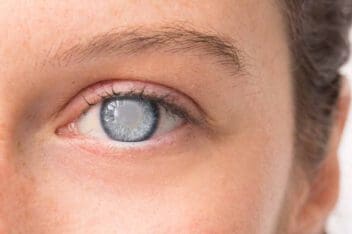Hispanic, Latino Communities & Eye Issues
Home / Vision Education Center / Eye Disease Statistics /
Last Updated:
Eye issues in the Hispanic/Latinx communities in the United States are among the highest in the country, with most people experiencing glaucoma and diabetic retinopathy as they get older.
Table of Contents
Eye diseases are becoming more common in this demographic, outpacing the development of the same conditions in the general population. Many people with these conditions do not seek help, which is often a result of many socioeconomic factors.
Highest Rates of Vision Loss

The National Eye Institute writes that “the Hispanic/Latinx population in the United States has some of the highest rates of vision loss and blindness” due to eye issues. Because of a combination of factors, these rates are on the rise.
Hispanic and Latinx people have above-average rates of vision loss and blindness and correspondingly high rates of diabetic retinopathy and glaucoma. In 2004, the Los Angeles Latino Eye Study tested over 6,300 participants and reported that Hispanic/Latinx people who had diabetes, who were widowed or divorced, or who were unemployed or older were more likely to have an eye condition that impaired their vision.
You deserve clear vision. We can help.
With 135+ locations and over 2.5 million procedures performed, our board-certified eye surgeons deliver results you can trust.
Your journey to better vision starts here.
Older Hispanic/Latinx people tended to have higher rates of ocular hypertension and glaucoma. More than 75 percent of the test subjects with glaucoma and 75 percent of those with ocular hypertension had not been diagnosed with either condition. Many of the study participants did not know they had vision problems.
Furthermore, the study revealed that Hispanic and Latinx people had high rates of early age-related macular degeneration, and over 10 percent of people in the study had diabetic macular edema (where people with diabetes have such high blood sugar that it damages the blood vessels in the retina). Of those 10 percent of people, 60 percent of them needed laser treatment. In addition, 20 percent of the participants had cataracts.
High Rates, Low Engagement

A 2015 survey revealed that almost 80 percent of Hispanic/Latinx people have some form of vision problems, to the point where it causes disruptions to their everyday life. However, many people in that group do not take the necessary steps to protect their vision or seek treatment if they have problems. Just 40 percent of Hispanic and Latinx people visited a doctor for a vision concern within the past year.
Researchers are troubled by this because of the rate at which Hispanic/Latinx people develop eye problems compared to the general population. They are also more likely to develop other health issues, such as diabetes and hypertension, which can contribute to vision problems and even result in blindness.
Adding to the problem is that half of Hispanic people do not know that they are at increased risk for these problems because of their ethnicity. Researchers have found that Hispanic/Latinx people “are more likely than any other demographic group to worry about developing vision problems,” but there are high rates of misinformation about eye health, a lack of education about eye conditions, and reduced access to health care in these populations.
For example, the Hispanic/Latinx demographic group is the most likely to believe that ultraviolet protection from the sun is needed only during spring and summer, while optometrists recommend that people have adequate protection from the sun’s UV rays all year round.
For this reason, not enough Hispanic and Latinx people are proactively trying to protect their eyes or getting information on how they can look after their eye health and get help when they notice something is wrong.
Increasing Rates of Eye Disease
About 80 percent of people responding in the survey also reported that they had other forms of visual disturbances, causing them to squint to be able to see clearly. They also experienced related eye strain, headaches, or fatigue.
Much more than the general population, Hispanic and Latinx people report that these eye issues cause problems with leisurely activities and work productivity. Men tend to report this to a greater degree than women.
The Los Angeles Latino Eye Study also reported that many eye diseases are becoming more common among Hispanic/Latinx people, and as the population of that group ages, this causes greater burdens to their communities.
In the four years of the study, participants developed vision problems and blindness at a rate that was higher than any other ethnic group in the United States (when compared to other population-based studies in the country). Almost 3 percent of Hispanic and Latinx people developed visual impairment in both eyes, mostly older adults.
You deserve clear vision. We can help.
With 135+ locations and over 2.5 million procedures performed, our board-certified eye surgeons deliver results you can trust.
Your journey to better vision starts here.
Diabetic Retinopathy & Cataracts

A crucial factor in this is that Hispanic/Latinx people were at a greater risk of developing diabetic retinopathy (a complication resulting from diabetes that affects the eyes) than people of white descent. Researchers noted that in this case, increasing age was not implicated in the development of diabetic retinopathy. Rather, people who had a longer duration of diabetes were more likely to then be diagnosed with diabetic neuropathy.
Additionally, Hispanic and Latinx people who already had some form of visual impairment — like blindness or diabetic retinopathy — in at least one eye were also more likely to develop the same condition in the other eye.
Hispanic/Latinx people tend to develop cataracts in the center of their lenses as opposed to the edge of their lenses. They also had relatively low rates of age-related macular degeneration, although this rate was likely to increase with age.
Eye Care Issues in Hispanic/Latinx Communities
One of the many takeaways from the study is the importance of regular eye care among Hispanic and Latinx people, especially those who are older, those who have diabetes or high blood pressure (or a family history of those conditions), and those who have some form of visual impairment.
Furthermore, researchers called on doctors to be aware of the risks their Hispanic/Latinx patients face, especially given that knowledge of the dangers of these conditions developing past the age of 40 is low. The study also found that over 60 percent of eye disease in Hispanic and Latinx people is both undiagnosed and undetected. These are the rates broken down by particular conditions:
- 98 percent: age-related macular degeneration
- 95 percent: diabetic retinopathy
- 82 percent: glaucoma
- 57 percent: cataracts
- 19 percent: refractive error
Socioeconomic Factors
As with the case of health care concerns for most minority ethnic groups, this could be attributed to a number of socioeconomic factors, such as a lack of access to educational resources regarding eye health, and a lack of access to insurance and health care to get treatment for eye diseases in the early stages of their development. The Brookings Institution writes that the Hispanic/Latinx communities in the U.S. often have poorer health outcomes because of this.
In September 2020, the Census Bureau noted that even though the poverty rate for Hispanic and Latinx people had reached historic lows the previous year, people in that minority group “continue to be overrepresented in poverty relative to their representation in the overall population.”
Among Hispanic and Latinx men, there may also be gender and cultural considerations of not wanting to admit to having a problem, not trusting doctors, and not wanting to seek help for their vision loss. Regardless of gender, Hispanic/Latinx people are “the least likely racial and ethnic group to see a doctor when they have health problems.”
This combination suggests that the Hispanic and Latinx communities face unique and significant challenges when it comes to vision health and outcomes. In 2018, researchers writing in JAMA Ophthalmology called for “culturally relevant and accessible campaigns” to reach Hispanic/Latinx people, especially those younger than 60 and those who live below the poverty line.
You deserve clear vision. We can help.
With 135+ locations and over 2.5 million procedures performed, our board-certified eye surgeons deliver results you can trust.
Your journey to better vision starts here.
References
- Eye Health Among Hispanics/Latinos. (July 2019). National Eye Institute.
- High Rates of Eye Diseases Found in Latino Eye Study. (August 2004). Healio.
- The Los Angeles Latino Eye Study: Design, Methods, and Baseline Data. (June 2004). Ophthalmology.
- Despite Higher Risks, Many Hispanic Adults Are Not Taking Steps to Protect Their Eye Health. (September 2015). PR Newswire.
- Sunglasses Should Be Worn All Year to Protect Eyes From UV Rays. (July 2011). Washington Post.
- U.S. Latinos Have High Rates of Developing Vision Loss and Certain Eye Conditions. (May 2011). Glaucoma Research Foundation.
- Diabetic Retinopathy in Hispanics: A Perspective on Disease Burden. (August 2018). American Journal of Ophthalmology.
- Latinos Often Lack Access to Healthcare and Have Poor Health Outcomes. Here’s How We Can Change That. (September 2020.) Brookings Institution.
- Inequalities Persist Despite Decline in Poverty for All Major Race and Hispanic Origin Groups. (September 2020). United States Census Bureau.
- Latino Men Are Much Less Likely to Seek Medical Care. That Worries Doctors. (April 2017). PBS.
- Americans Are Visiting the Doctor Less Frequently, Census Bureau Reports. (October 2012). United States Census Bureau.
- Eye Health Knowledge and Eye Health Information Exposure Among Hispanic/Latino Individuals. (August 2017). JAMA Ophthalmology.
This content is for informational purposes only. It may have been reviewed by a licensed physician, but is not intended to serve as a substitute for professional medical advice. Always consult your healthcare provider with any health concerns. For more, read our Privacy Policy and Editorial Policy.
